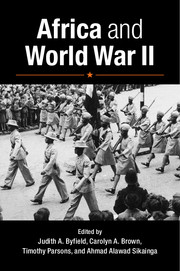Book contents
- Frontmatter
- Dedication
- Contents
- List of Contributors
- Acknowledgments
- Preface
- ONE INTRODUCTION
- TWO COLONIAL SUBJECTS AND IMPERIAL ARMIES
- THREE MOBILIZING COMMUNITIES AND RESOURCES FOR THE WAR EFFORT
- 8 Women, Rice, and War: Political and Economic Crisis in Wartime Abeokuta (Nigeria)
- 9 Africa's “Battle for Rubber” in the Second World War
- 10 Freetown and World War II: Strategic Militarization, Accommodation, and Resistance
- 11 Extraction and Labor in Equatorial Africa and Cameroon under Free French Rule
- 12 The Portuguese African Colonies during the Second World War
- 13 World War II and the Transformation of the Tanzanian Forests
- FOUR RACE, GENDER, AND SOCIAL CHANGE IN A TIME OF WAR
- FIVE EXPERIENCING WAR IN AFRICA AND EUROPE
- SIX WORLD WAR II AND ANTICOLONIALISM
- SEVEN CONCLUSION
- Index
10 - Freetown and World War II: Strategic Militarization, Accommodation, and Resistance
from THREE - MOBILIZING COMMUNITIES AND RESOURCES FOR THE WAR EFFORT
Published online by Cambridge University Press: 05 May 2015
- Frontmatter
- Dedication
- Contents
- List of Contributors
- Acknowledgments
- Preface
- ONE INTRODUCTION
- TWO COLONIAL SUBJECTS AND IMPERIAL ARMIES
- THREE MOBILIZING COMMUNITIES AND RESOURCES FOR THE WAR EFFORT
- 8 Women, Rice, and War: Political and Economic Crisis in Wartime Abeokuta (Nigeria)
- 9 Africa's “Battle for Rubber” in the Second World War
- 10 Freetown and World War II: Strategic Militarization, Accommodation, and Resistance
- 11 Extraction and Labor in Equatorial Africa and Cameroon under Free French Rule
- 12 The Portuguese African Colonies during the Second World War
- 13 World War II and the Transformation of the Tanzanian Forests
- FOUR RACE, GENDER, AND SOCIAL CHANGE IN A TIME OF WAR
- FIVE EXPERIENCING WAR IN AFRICA AND EUROPE
- SIX WORLD WAR II AND ANTICOLONIALISM
- SEVEN CONCLUSION
- Index
Summary
Though its contribution is little known, Freetown, the capital of the colony of Sierra Leone, was central to Allied strategy for several years, primarily as a convoy station. The British started preparing the city for war in 1938, and the next year set in motion a comprehensive militarization. In 1942 and 1943, the United States joined Britain with military installations, officers, and troops stationed there, and the two powers carried out joint construction of port facilities. During the peak period, up to 200 cargo and military vessels might be moored in Freetown's wide, well-protected harbor: Hundreds of convoys formed there, mostly Europe-bound, and many thousands of soldiers and sailors passed through the port. Freetown residents took on a wide variety of skilled and semiskilled jobs related to the war, and tens of thousands of migrants flowed in from the protectorate to load and unload ships, build infrastructure, and handle many other tasks. In the face of arduous work conditions, rising food prices, and low wages, laborers staged strikes and other actions, while residents challenged imperial and Allied designs in other ways. Sierra Leone was also affected by the large numbers of whites and Africans from other colonies who were stationed in or passed through Freetown and nearby bases. Racial, ethnic, and class tensions marked the war era, resulting in tussles on the street, fights, and even deaths. While most of those mobilized for civilian and military service were men, African women were also deeply affected by the war and acted to protect their interests. All in all, colonial and military officers sought to gain the compliance of Freetown's populace with extraordinary wartime measures through both coercive and subtle techniques, including propaganda. Africans accommodated in various ways and professed their loyalty, but also challenged demands and controls. Many issues were bargained out, and authorities often had to give ground.
Freetown's militarization and subsequent demilitarization followed one time arc that reflected the place of the harbor and city in the overall Allied strategy and also another time arc that involved the British administration's desire to manage the population, the war-distorted economy, and African challenges to policies and practices.
- Type
- Chapter
- Information
- Africa and World War II , pp. 183 - 199Publisher: Cambridge University PressPrint publication year: 2015
- 3
- Cited by

